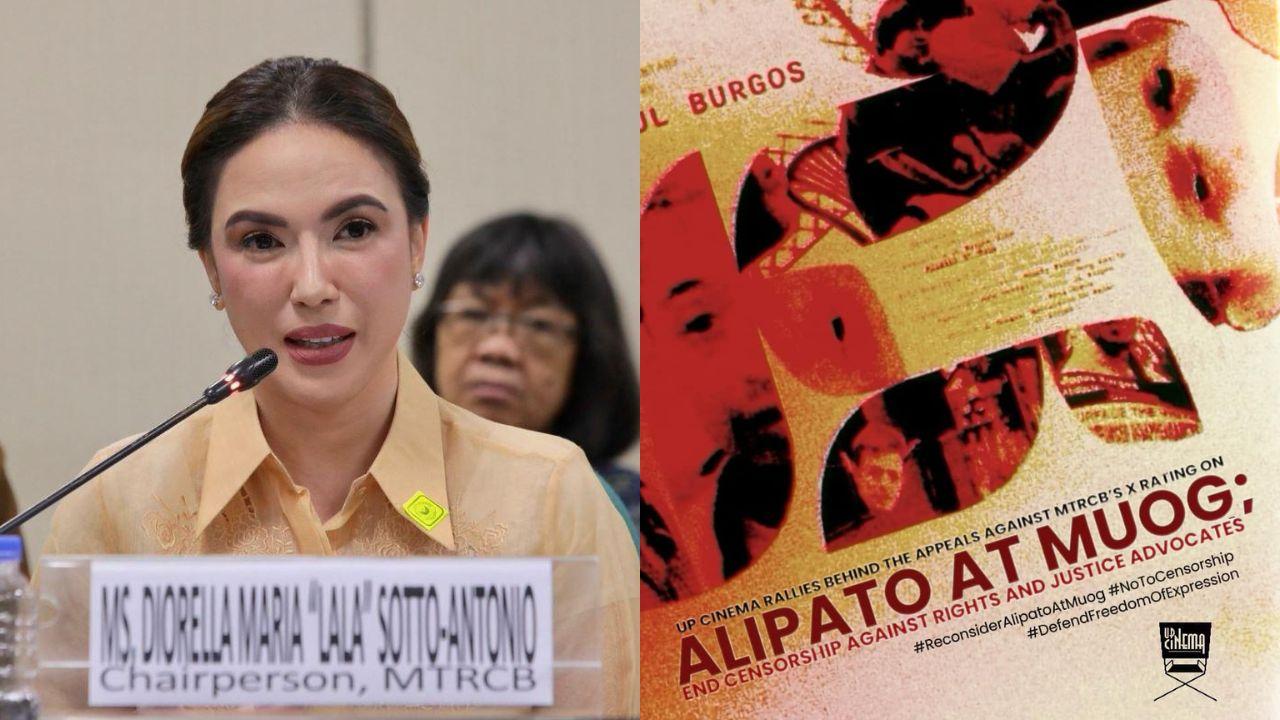The director of documentary ‘Alipato at Muog’ on Wednesday refuted the explanation of Movie and Television Review and Classification Board (MTRCB) chairperson Lala Sotto-Antonio on the agency’s decision to give the film an X rating.
In a Facebook post, director JL Burgos clarified that the screening and the PG rating of the documentary film during this year’s Cinemalaya Film Festival was due to an “agreement between Cinemalaya and the MTRCB for self-rating.”
“The Cinemalaya Festival PG rating of ‘Alipato at Muog’ is self-rated…It is not the MTRCB who gave the rating,” Burgos said.
Further, Burgos explained they were able to play the documentary film at the University of the Philippines because state universities and colleges are not covered by MTRCB’s jurisdiction.
“In fact, all State Universities and Colleges are independent of MTRCB. Which means the MTRCB CANNOT stop such screenings. So citing these screenings as NOT CURTAILMENT OF FREEDOM OF EXPRESSION is not accurate – the MTRCB did not allow such screenings, they simply don’t have jurisdiction in theaters inside SUCs,” Burgos stressed.
During the Senate finance subcommittee’s hearing on MTRCB’s proposed budget for 2025, Sotto-Antonio maintained they did not infringe on the right to freedom of expression as she noted that they have given an exemption permit for the documentary film’s public exhibition during this year’s Cinemalaya Film Festival and did not stop the producers of the film to conduct academic film showings of “Alipato at Muog.”
In the same Facebook post, Burgos disclosed the contents of their appeal to the MTRCB to conduct a second review of the documentary film. Burgos’ letter included the details of the board’s decision.
According to Burgos, some of the details that the documentary film reviewers raised relative to the MTRCB decision are:
- The case is still ongoing. One of the reviewers even went out of his way to call his contacts in the Court of Appeals to ask about the case if there is still an ongoing case. His contact said the case is still ongoing.
- Reviewers also said that we should have included the Supreme Court and Court of Appeals decisions in the documentary for fairness.
- The reviewers also cited this clause in the MTRCB blue book: Those which may constitute “contempt of court” or contempt of any quasi-judicial tribunal or those that pertain to matters which are sub-judice in nature; If we can, however, present an ORIGINAL with a Court Stamped document of the decision of the court with finality, then they can reconsider.
- They also said that there are some scenes pertaining to some evidence presented which may have not been presented to the court, like the names of the persons involved, they are not comfortable with that.
- According to the reviewers, a disclaimer should have been attached to the scene when a military official claims that the military was trained to kill. That the opinion was his own.
- Footages that were shot by the team were also questioned on how we were able to shoot it. Specifically the scene at the Senate hearing on the appointments of military officials. They claimed that it should be labeled that it came from a news agency. They asked how we were able to shoot it and under whose courtesy.
- Military official named in the film – General Año who is now the sitting National Security Adviser, should have been given a chance to explain. The reviewers also said that General Año is not convicted in the same breath fearing retribution from the General. While they didn’t think it would happen, they feared General Año might get back at them. Reviewers suggested a disclaimer should be included in Gen. Año’s footage.
- Subversiveness- when asked about the specifics they said NAPAKARAMI.
- At the last part of the movie, where chants and voice over were heard to continue to fight for justice and fight for the disappeared, PARANG LEFTISTS DAW ANG DATING, pwede naman daw sabihin ipaglaban pero ipapalabas daw ito sa mas marami, sa kanilang mandato bawal daw ito.
Burgos asserted the case of Jonas Burgos, who was the main subject of the documentary film, has been finalized since 2017 and the Supreme Court ruling, including the decisions of the Court of Appeals and the Regional Trial Court were all included in the documentary “contrary to what the reviewers insisted.”
“The reviewer’s claim that there is still an on-going case is hearsay. A photocopy of the rulings will also be provided to your good office. Should your good office still insist on a court-stamped document, we would like to ask for a certification from the Court Of Appeals about the reviewer’s claim,” Burgos said.
He refuted the claim that there were some scenes pertaining to pieces of evidence, including the names of the persons involved, which were not presented before the court.
According to Burgos, the documentary was “based on all available information” and the other provided information in the documentary “was vital in truth-telling so that the viewers will fully understand the story.”
“With regards to the reviewers’ discomfort that there are no disclaimers especially for the military official expressing his own opinion, it is usually understood that individuals in documentaries are expressing their own opinions. It is also the discretion of the director/filmmaker whether to put a disclaimer or not,” he went on.
On the questions on the footage of the Senate hearings which were included in the documentary film, Burgos said the clips that were part of the film were owned by them.
“It is properly labeled on the upper left part of the screen. We also feel there is no need to divulge under whose courtesy was secured to film in the Senate,” he said.
“The same goes for Gen. [Eduardo] Año’s senate hearing footage. Apart from the director’s discretion, we have included the part where public officials in the senate hearing championed Año which paved the way for his appointment. Also, at the end of the documentary, an epilogue was flashed on black background with white text font stating that he is now the National Security Adviser,” he added.
On the reviewer’s possible retaliation from National Security Adviser Eduardo Año, Burgos said they “feel that one documentary would not put their lives at risk.” He then appealed to the MTRCB chair to alleviate these fears.
Burgos likewise refuted the claim that the film shows “subversiveness,” saying that “there is nothing subversive about a family’s search for justice.”
“Alipato at Muog is a stand against enforced disappearance and human rights violations. Additionally, there is no subversion law in the Philippines,” he said.
“In line with being left, may we know the definition of being LEFT? Are we penalizing a political belief here? Because again we will reiterate our stand that the documentary is not subversive at all and it is a basic right in a democratic country for victims of injustices to voice out their grievances,” he went on.
In ending his appeal to MTRCB, Burgos asked the agency to take another look at the documentary film “with an open mind and an open heart.”
“Our documentary is not fiction. It is a story of a family searching for their missing loved one. It is about human rights and the pursuit for justice,” he said.
According to Sotto-Antonio, the agency has already scheduled its second review on the documentary film on September 5.
“Alipato at Muog” is an independently produced documentary film which centered on the search for truth behind the abduction of activist Jonas Burgos in 2007. Jonas is the brother of JL Burgos, the director of the film.
The documentary film premiered in this year’s Cinemalaya Film Festival and was awarded with the Special Jury Award for full length film.


















